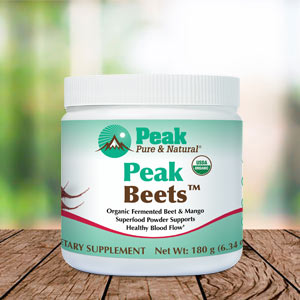Get Easy Health Digest™ in your inbox and don’t miss a thing when you subscribe today. Plus, get the free bonus report, Mother Nature’s Tips, Tricks and Remedies for Cholesterol, Blood Pressure & Blood Sugar as my way of saying welcome to the community!
Survive the heat with a single supplement

Summer heat kills. It can be hazardous if you live in a big city. But you can help your body shrug off the dog days of summer with a simple vitamin.
As you age, your body’s ability to cope with high temperatures drops. The reason: Older blood vessels have a tougher time dilating so that your circulation, which functions like the cooling system in a car engine, can keep the blood flowing freely, dissipating heat.
According to scientists at Penn State, taking supplements of folate, the B vitamin found in green leafy vegetables can keep your blood moving, cooling your skin and reducing your risk for heart problems.
The nitric oxide connection
“We know that when older adults are exposed to heat, their bodies are not able to increase skin blood flow to the same extent that young subjects do, and as a consequence, older adults are at a greater risk for cardiovascular events, such as heart attack and stroke, during environmental heat waves,” says researcher Anna Stanhewicz.
The body depends on the production of nitric oxide to widen its blood vessels and stay cool. However, our ability to make this substance slows with the passing years.
“When young, healthy people are exposed to heat, their bodies increase blood flow to the skin and this increased flow, combined with sweating, helps to cool the body down,” says Stanhewicz.
To make vessel-widening nitric oxide the body needs an enzyme named tetrahydrobiopterin (BH4). Taking folate increases the supply of BH4.
The Penn State researchers used folic acid in their study. Their study showed that the B vitamin worked as well in helping people keep their cool as did an expensive drug.
“The bottom line is that folic acid supplementation increased nitric oxide production in older blood vessels,” Stanhewicz says. “In the past, studies conducted in our lab showed that we can increase nitric oxide production, and then consequently reflex skin blood flow, in older adults by giving them an expensive pharmaceutical. So in this study, we wanted to test that again, but with an inexpensive treatment that might work the same way.”
Stanhewicz and her fellow researchers gave their subjects 5 milligrams of folic acid. Taking folate should be even more effective.
But maybe even a less expensive way to boost nitric oxide levels is to eat foods like beets, spinach, bok choy, fennel and parsley. You’d need to eat a little every day as these foods help the body make a supply of nitric oxide that last roughly about 24 hours, depending on their dietary nitrate content.
You’ll get the biggest bang for your buck from beets, which are not only the richest source, but are also the most bioavailable–meaning the body can put nitrates from beets to work fast.
Editor’s note: There are perfectly safe and natural ways to decrease your risk of blood clots including the 25-cent vitamin, the nutrient that acts as a natural blood thinner and the powerful herb that helps clear plaque. To discover these and other secrets of long-lived hearts, click here for Hushed Up Natural Heart Cures and Common Misconceptions of Popular Heart Treatments!













